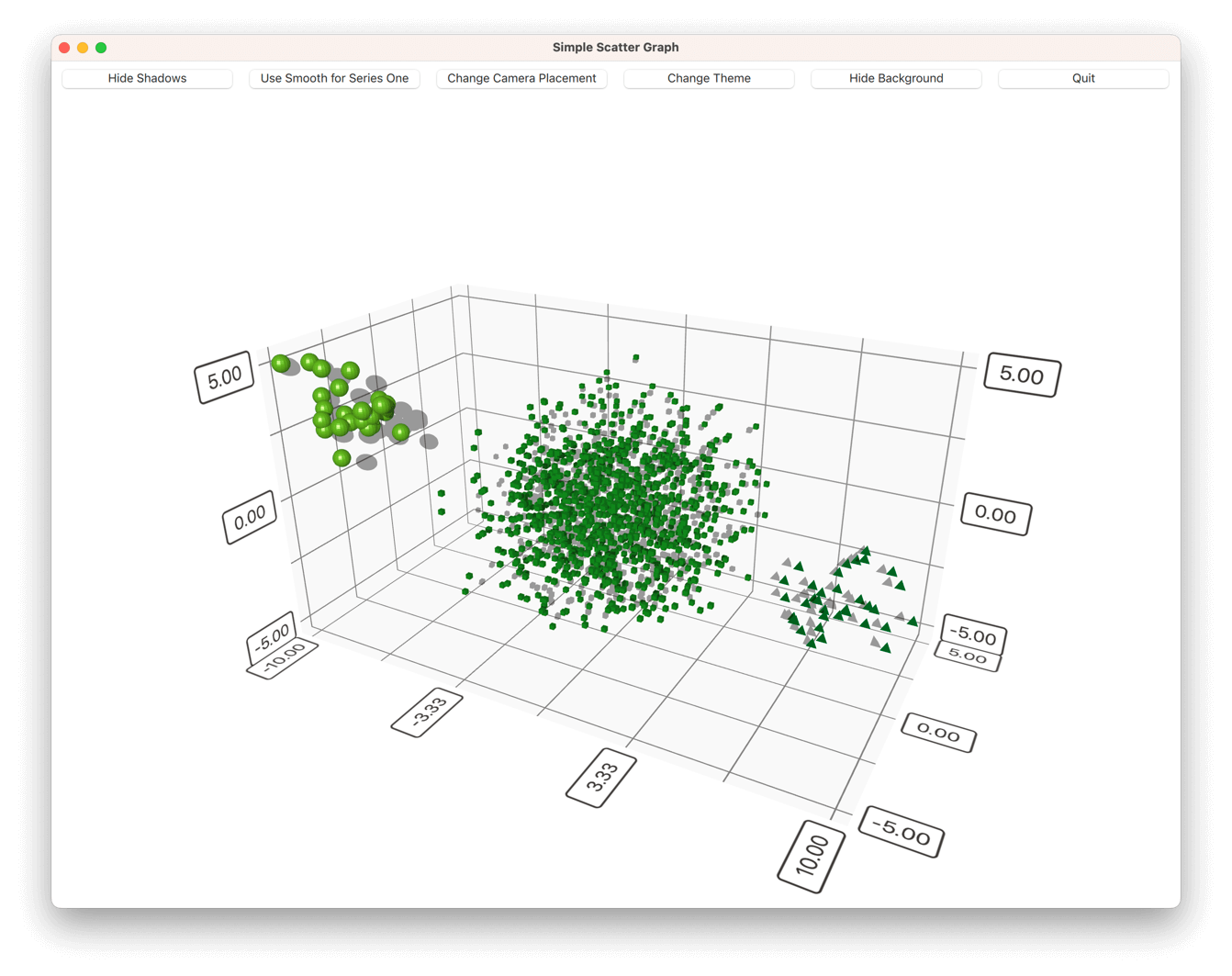使用 Scatter3D in a QML application.
Simple Scatter Graph shows how to make a simple scatter graph visualization using Scatter3D and QML.
For instructions about how to interact with the graph, see this page .
For instructions on how to create a new Qt Quick application of your own, see Qt Creator help.

要运行范例从 Qt Creator ,打开 Welcome 模式,然后选择范例从 Examples 。更多信息,拜访 构建和运行范例 .
Before diving into the QML code, take a look at the application
main.cpp
.
This application implements a 'Quit' button in the UI, so you want to connect the QQmlEngine::quit () signal to the application's QWindow::close () 槽:
QObject::connect(viewer.engine(), &QQmlEngine::quit, &viewer, &QWindow::close);
To make deployment a little simpler, gather all of the application's
.qml
files to a resource file (
qmlscatter.qrc
):
<RCC>
<qresource prefix="/">
<file>qml/qmlscatter/Data.qml</file>
<file>qml/qmlscatter/main.qml</file>
</qresource>
</RCC>
This also requires setting the
main.qml
to be read from the resource (
qrc:
):
viewer.setSource(QUrl("qrc:/qml/qmlscatter/main.qml"));
When using cmake instead of qmake, the
.qml
files are added into a QML module in the
CMakeLists.txt
instead:
qt6_add_qml_module(qmlscatter
URI Scatter
VERSION 1.0
NO_RESOURCE_TARGET_PATH
QML_FILES
qml/qmlscatter/Data.qml
qml/qmlscatter/main.qml
)
Finally, make the application run in a maximized window:
viewer.showMaximized();
First, import all the needed QML modules:
import QtQuick import QtQuick.Controls import QtDataVisualization
Then, create the main
Item
and call it
mainView
:
Item { id: mainView
Then, add another
Item
inside the main
Item
, and call it
dataView
. This will be the item to hold the
Scatter3D
graph. Anchor it to the parent bottom:
Item { id: dataView anchors.bottom: parent.bottom
Next, add the
Scatter3D
graph itself. Add it inside the
dataView
and name it
scatterGraph
. Make it fill the
dataView
:
Scatter3D { id: scatterGraph anchors.fill: parent
Now the graph is ready for use, but has no data. It also has the default axes and visual properties.
Next, modify some visual properties first by adding the following inside
scatterGraph
:
theme: themeQt shadowQuality: AbstractGraph3D.ShadowQualityHigh scene.activeCamera.cameraPreset: Camera3D.CameraPresetFront
A customized theme was added, the shadow quality changed, and the camera position adjusted. The other visual properties are fine, so there is no need to change them.
The custom theme is based on a predefined theme,
Theme3D.ThemeQt
, but the font in it is changed:
Theme3D { id: themeQt type: Theme3D.ThemeQt font.pointSize: 40 }
Then, start feeding the graph some data.
创建
数据
item inside the
mainView
and name it
seriesData
:
Data { id: seriesData }
The
seriesData
item contains the data models for all three series used in this example.
This is the component that holds the data in
Data.qml
. It has an
Item
as the main component.
In the main component, add the data itself to a
ListModel
and name it
dataModel
:
ListModel { id: dataModel ListElement{ xPos: -10.0; yPos: 5.0; zPos: -5.0 } ...
Add two more of these to the other two series, and name them
dataModelTwo
and
dataModelThree
.
Then, expose the data models to be usable from
main.qml
. Do this by defining them as aliases in the main data component:
property alias model: dataModel property alias modelTwo: dataModelTwo property alias modelThree: dataModelThree
Now you can use the data from
Data.qml
with
scatterGraph
in
main.qml
. First, add a
Scatter3DSeries
and call it
scatterSeries
:
Scatter3DSeries { id: scatterSeries
Then, set up selection label format for the series:
itemLabelFormat: "Series 1: X:@xLabel Y:@yLabel Z:@zLabel"
And finally, add the data for series one in a
ItemModelScatterDataProxy
. Set the data itself as the
itemModel
for the proxy:
ItemModelScatterDataProxy { itemModel: seriesData.model xPosRole: "xPos" yPosRole: "yPos" zPosRole: "zPos" }
Add the other two series in the same way, but modify some series-specific details a bit:
Scatter3DSeries { id: scatterSeriesTwo itemLabelFormat: "Series 2: X:@xLabel Y:@yLabel Z:@zLabel" itemSize: 0.05 mesh: Abstract3DSeries.MeshCube ...
Then, modify the properties of the default axes in
scatterGraph
a bit:
axisX.segmentCount: 3 axisX.subSegmentCount: 2 axisX.labelFormat: "%.2f" axisZ.segmentCount: 2 axisZ.subSegmentCount: 2 axisZ.labelFormat: "%.2f" axisY.segmentCount: 2 axisY.subSegmentCount: 2 axisY.labelFormat: "%.2f"
After that, add a few buttons to the
mainView
to control the graph, one of which is shown as an example:
Button { id: shadowToggle width: mainView.buttonWidth // Calculated elsewhere based on screen orientation anchors.left: parent.left anchors.top: parent.top anchors.margins: 5 text: scatterGraph.shadowsSupported ? "Hide Shadows" : "Shadows not supported" enabled: scatterGraph.shadowsSupported onClicked: { if (scatterGraph.shadowQuality === AbstractGraph3D.ShadowQualityNone) { scatterGraph.shadowQuality = AbstractGraph3D.ShadowQualityHigh; text = "Hide Shadows"; } else { scatterGraph.shadowQuality = AbstractGraph3D.ShadowQualityNone; text = "Show Shadows"; } } }
Then, modify
dataView
to make some room for the buttons at the top:
Item { id: dataView anchors.bottom: parent.bottom width: parent.width // Adjust the space based on screen orientation: // If we're in portrait mode, we have 3 rows of buttons, otherwise they are all in one row. height: parent.height - (mainView.portraitMode ? shadowToggle.implicitHeight * 3 + 25 : shadowToggle.implicitHeight + 10) ...
And you're done!